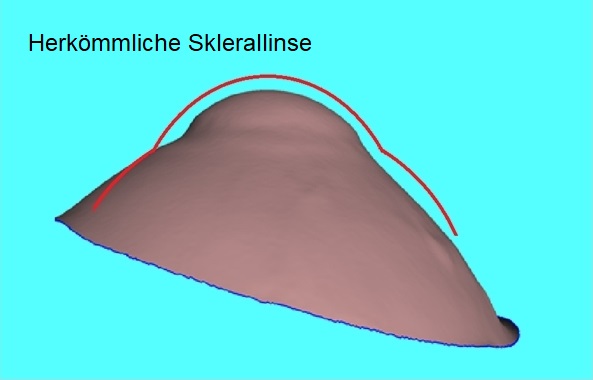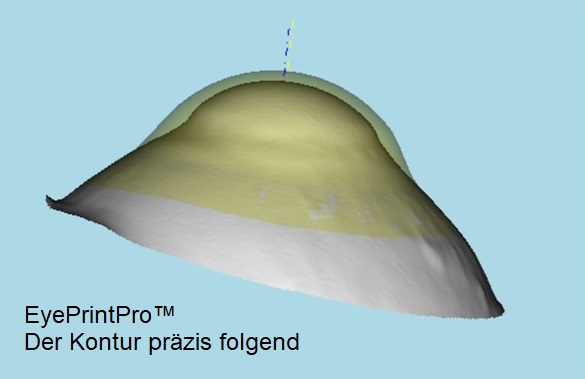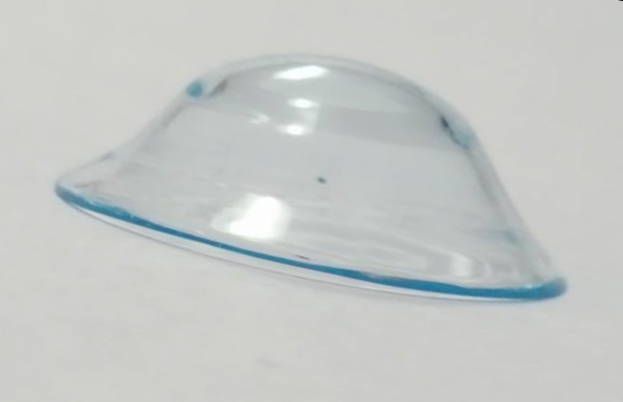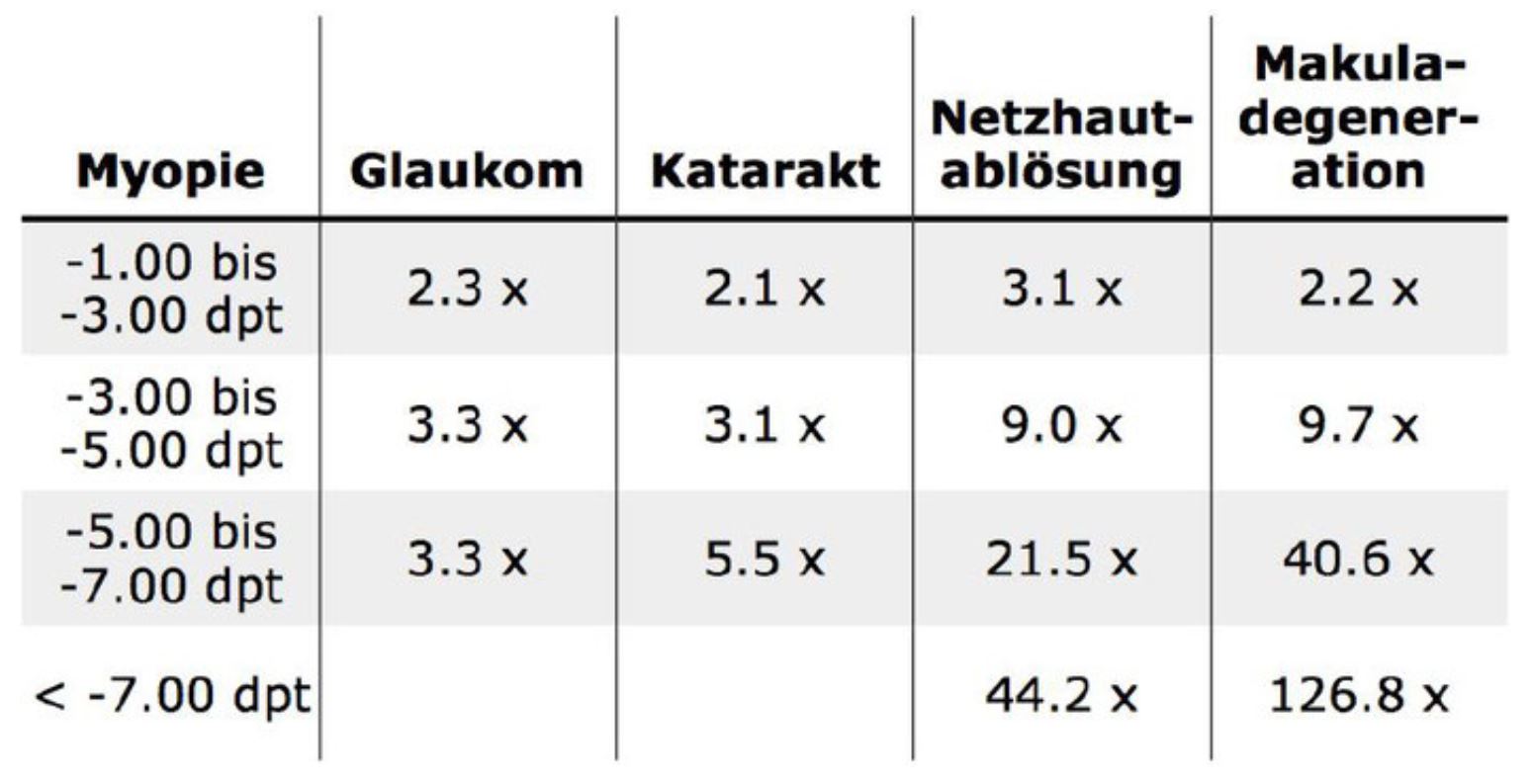Keratoconus and other Corneal Irregularities
Keratoconus, Keratoglobus, Pellucide Marginal Degeneration as well as corneal scars due to trauma or certain surgery show as irregularities of the corneal surface. In most cases, the image on the retina is disturbed in such a way that satisfactory vision cannot be achieved with the regular optics of spectacle lenses.
In these cases a "rigid gas permeable contact lens" (RGP) is usually the first choice because existing irregularities ar largely compensated by the tear film between contact lens and cornea. A wide range of contact lens geometries and materials are available for individual treatment and optimal care.
Scleral lenses as well as mini scleral lenses are larger than conventional RGP contact lenses. They are usually fit if corneal topography or practical reasons do not allow equipment with RGP contact lenses.
Soft contact lenses may also enable better vision than spectacle lenses, particularly in mild cases of irregularity. The proximity to the surface of the tearfilm may bring a less distorted image and a wider field of vision compared to spectacles. Usually an individually designed soft contact lens is superior to standardised frequent replacement lenses.
The diversity of anatomic and morphologic structures of irregular corneas require unique solutions in order to achieve an optimal longterm compatibility and comfort.
For decades we have been taking care of a large number of persons concerned. We share and discuss our experience at international symposia and conventions. We take advantage of collaboration with institutions and other renowned specialists to widen our knowledge and perspectives regarding these topics, leading to expertise.
Further information on this topic can be found under the following link.
EyePrintProTM



The goal of EyePrintPro™ is, to provide the best possible vision and therefore a better quality of life to people who are currently without alternative solution to correct their corneal irregularity / disease.
For which cases is the EyePrintPro™ scleral lens appropriate?
Irregular eye surfaces, severely deformed eyes, as well as ocular surface disease associated with dry eye, that cannot be treated satisfactory with soft or rigid gaspermeable contact lenses or conventional scleral lenses. This may occur in case of:
- Keratoconus
- Pellucid Marginal Degeneration(PMD)
- Pterygium
- Status following accident
- Status following chemical burn
- Status following infection
- Post surgical i.E..:
- Corneal transplant
- Radial keratotomy
- Post LASIK ectasia etc.
- Additional features:
- Correction of residual astigmatism
- Presbyopia management
- Correction of residual astigmatism and presbyopia
- Prismatic correction up to 4 cm/m
What distinguishes EyePrintPro™ from conventional contact lenses / scleral lenses?
The EyePrintPro™ scleral lens is unique for each eye, like a fingerprint. This is the most important among the new and vital achievements to provide improved patient satisfaction.
We start with the EyePrint impression procedure, which takes just a few minutes and records the exact curvatures of the entire ocular surface. This comfortable and gentle procedure provides more information than high-tech computer topography scanners and gives us, as certified specialists, the opportunity to precisely detect complex irregularities of the ocular surface.
The EyePrint process provides details about the eye surface that have never been captured before. The production of EyePrintPro™ is so precise that these details are important. No guessing is necessary and there is no misjudgement. The concerned person gets exactly what he/she needs.
The EyePrint impression is sent to EyePrint Prosthetics LLC for digitizing and designing the EyePrintPro™ scleral lens. The latest technology in 3D scanning and CNC-controlled processing systems allows accurate alignment to each cornea and sclera.
The EyePrintPro™ is made of a highly oxygen-permeable material with high-quality optics, therefore the wearers of EyePrintPro™ receive a maximum of comfort and vision as well as minimized metabolic burden to the Cornea.
Children and Contact Lenses
Over many years we have continuously broadened the specific knowledge and experience for the care of infants, toddlers and young people with contact lenses. This area of our activities is of great concern to us, as it is an important component in the development of these children.
Care is usually provided in an interdisciplinary collaboration between the ophthalmologist, orthoptist and optometrist.
The fitting of contact lenses in infants and toddlers is done for medical-therapeutic or opto-therapeutic reasons.
For example, newborns and infants born with cataracts ( opacity of the eye lens) are fitted with contact lenses as soon as possible after cataract surgery, as these lenses allow a normal visual experience.
For children and adolescents with severe ametropia, correction with contact lenses is often also the first choice in order to achieve the best conditions for good visual acuity and binocular and thus three-dimensional vision.
The ability to see clearly and three-dimensionally is achieved through constant practice. From the first day on, a child automatically trains its eyes, in case of ametropia with glasses or contact lenses as an aid, until this learning process is usually completed in the 7th-8th year of life. The vision of every child should therefore be assessed by an ophthalmologist as early as possible, especially if ametropia is suspected.
Contact lenses are also suitable for children with vision impairments without medical-therapeutic necessity. In contrast to glasses, contact lenses do not press on the nose, do not fog up, offer clear vision even in rain and can neither slip off the nose nor break during use. While all these aspects can increase the enjoyment of sporting activities, the two types of visual aids are not mutually exclusive. In any case, spare spectacles are important, often for alternate wearing, according to needs and situation.
The choice of the type of contact lenses depends on the issues regarding the suitable correction system and the present prescription. Usually there are different possibilities, the contact lenses are always customized according to the individual requirements.
Important for an optimal result, especially for babies and toddlers, is the cooperation with the parents, as well as the empathetic care and accompaniment by us. The regular, at the beginning tightly scheduled checks are important to take into account the changing circumstances, especially because of the fast growth in the first years of life.
Of course, we are always available to answer any questions, in order to offer parents of children optimal support.
Myopia Management
In case of myopia, the view into the distance is blurred, e.g. the blackboard at school. Myopia is a common refractive error that usually begins in children of school age and may progress for a number of years.
The frequency of myopia has increased significantly worldwide in the last 2-3 decades. The causes are not fully understood, but genetic and environmental factors seem to have a significant influence. The latter include, for example, the intensity and duration of schooling, the duration of daily near work, the amount of time spent outdoors and urban or rural environments.
The most common form of myopia is caused by longitudinal growth of the eyeball, which stretches the retina and thus increases the risk of possible complications later in life. High myopia raises the risk of pathological changes such as retinal detachment, myopic maculopathy, cataract and glaucoma.
The following table shows the increased risk for eye disease in myopia:

Tabelle: Gifford, Kate: Preparing for the Myopia Control Stampede, Contact Lens Spectrum, 2016; Flitcroft, D.I.: The complex interactions of retinal, optical and environmental factors, Progress in Retinal and Eye Research, 2012
Progressive myopia can be slowed down by various measures. Part of this can be achieved by changes in behaviour, such as spending at least one hour a day outdoors in daylight, keeping a minimum distance of 30 - 40 cm when seeing in the vicinity, and regularly looking into the distance when doing close work for longer periods of time.
According to scientific research, the most effective method of reducing eye length growth is drug therapy with locally applied atropine eye drops. This therapy is prescribed by an ophthalmologist and can be combined with the night lenses mentioned below to achieve the highest possible slowing down of progression.
Ortho-K contact lenses, so-called "night lenses", offer almost the same reduction in myopia increase as drug therapy. As with atropine therapy, the effect that inhibits eye length growth is not completely understood, but is well documented.
Another possibility is provided by soft or rigid gaspermeable multifocal contact lenses, the effectiveness of which is controversially discussed in various studies.
Each of the described methods has its advantages and disadvantages and especially in the field of contact lenses, both Ortho-K-lenses and multifocal contact lenses, new developments are constantly being researched.
We are happy to advise you, taking into account the individual situation of your child and the latest developments to work out the best course of action together with you.

